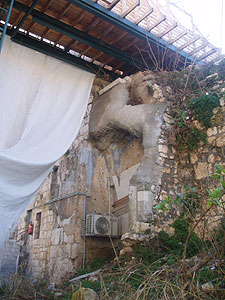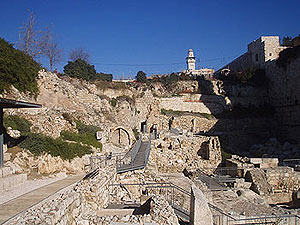
Remains of the old ramp's collapse
The Israel Antiquities Authority has begun salvage excavations in the Archeological Park, for the purpose of erecting supporting pillars for a permanent Mugrabim Ramp, to be built for the benefit and safety of visitors. The new ramp will replace the temporary wooden bridge which was established following the collapse of the old Mugrabim Ramp, which was declared a "hazardous structure". The salvage excavations are standardized archeological excavations which are carried out in declared archeological sites slated for construction and development. The purpose of the salvage excavations is to prevent and minimize damage which could be caused to ancient remains as a result of the construction.
The new Mugrabim Ramp, which will be built by the Jerusalem Municipality, will replace the temporary wooden bridge, which was built following the partial collapse of the old ramp and its declaration as a public hazard. The collapse of the old ramp was the result of natural disasters over the years, and it occurred shortly after the earthquake and snowstorms which struck Jerusalem in February 2004. In light of the real and imminent threat to visitors, whose entry into the Temple Mount was authorized only through the ramp, the Israel Antiquities Authority immediately agreed to conduct continuous archeological inspections for the purpose of erecting the temporary bridge.

The Jerusalem Archaeological Park
Once plans for the establishment of a permanent ramp were made known, the Israel Antiquities Authority conditioned its construction on the implementation of salvage excavations, as required by the Israeli Antiquities Law. In accordance with this Law, any construction on declared antiquities sites, such as Jerusalem in general and the Old City in particular, must be carried out with the approval of the Israel Antiquities Authority and must conform to its instructions.
The salvage excavations in the compound are directed by a team of archeologists and professionals, experts in their fields, using internationally accepted methods employed in excavations in similar areas, and in accordance with the nature and type of the artifacts exposed. The excavations will take place, as is customary, during the winter and under the cover of several hothouses. The removal of the remains of the old ramp will be carried out prior to the commencement of the archeological excavations, using a small mechanical tool (backhoe) and under tight inspection by archeologists. Only once the excavations are completed will the exact location of the bridge pillars in the Archeological Park compound be determined. The construction of the pillars will be carried out in accordance with the instructions of the Israel Antiquities Authority, while ensuring the preservation and protection of the monuments which will be exposed. The archeological excavations, which will last several months, will provide an opportunity to study the nature of the archeological remains in the site, and their contribution to studying Jerusalem's history is expected to be substantial.
The archeological remains which will be revealed will be preserved and incorporated in an Archeological Park which will be opened for the benefit of visitors from Israel and tourists from around the world.
Additional Articles ...